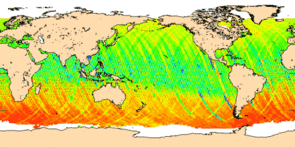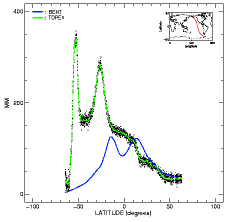Solar storm warning
Image of the Month - November 2000
The solar wind consists of a constant stream of charged particles flowing outward from the Sun. Most of these particles are deflected by the Earth's magnetic field. But some get through to the ionosphere, in particular over the poles and the South Atlantic Anomaly, and interact with the atmosphere. These particles can also inflict damage on satellites and their instruments.
Altimetry satellites are sensitive to the solar wind, as it increases the electron content in the ionosphere. Because electrons slow down the altimeter's radar signal, we need to keep constant track of electron content to obtain the most accurate altimetry data possible. We measure signal path delay by comparing the round-trip time between the satellite and the Earth's surface at two separate frequencies. Since this delay varies with signal frequency, we can work out by how much the altimeter range has been overestimated.
The Topex altimeter and the Doris location system on Topex/Poseidon are dual-frequency instruments designed to help us estimate ionosphere corrections. Measuring every factor affecting altimetry data with the utmost accuracy is the only way to sustain the very high level of quality we have today.
See also:
- Altimetry: Why satellite altimetry ?
Websites on this subject:
- Solar wind
- Surfing the solar wind (Nasa science update)






